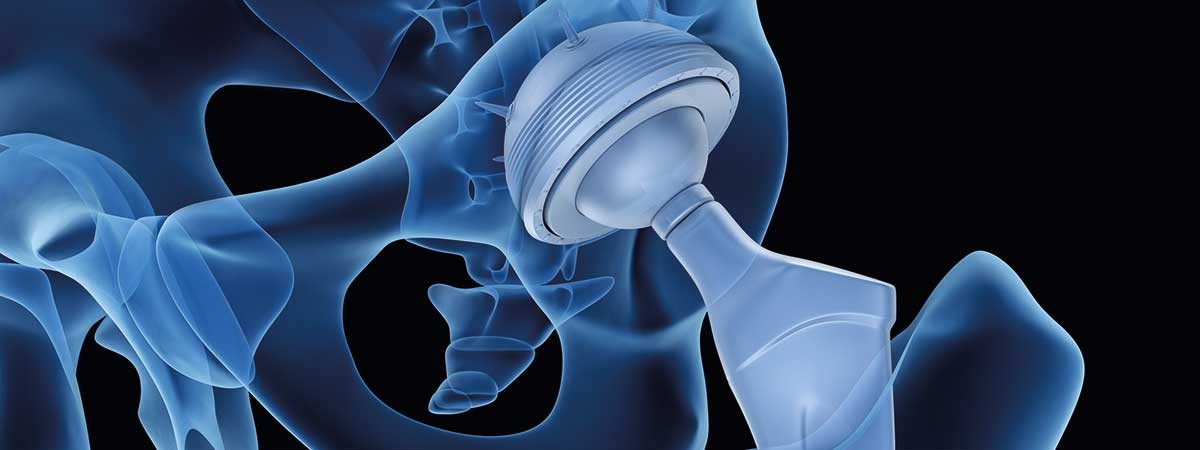Lots of artificial joints are embedded directly into bones without any aids. Porous structures on their surfaces enable a secure bone ingrowth. Vacuum plasma spraying gives them the required shape and stability.
Human bones are in a constant process of remodeling. Scavenger cells constantly gnaw their way around the bone. At the same time, the body produces cells from osteoblast and these cells are used to make new bone. That is why a broken bone will grow back together relatively quickly. This same mechanism allows artificial joints to be embedded directly into the bones without needing any bone cement.
A solid bond
When a fracture is healing, bone meets bone. However, when dealing with an implant, the bone hits a metal foreign object. To allow it to grow in, it has to offer the trabaculae a good surface to attach to. The trabaculae are small rods that form a three-dimensional grid structure inside the bone. Ideally, they will hit pores that correspond to their strength. At the same time, these cavities have to be deep enough for the trabaculae to get a strong enough hold.
In terms of material engineering, this poses an enormous challenge: the implant has to provide a porous surface while still being able to withstand enormous loads over a number of years. Implant components are therefore made from highly stable titanium alloys. To create the smooth surface, they require a coating that can form a – literally – unbreakable bond with the substrate. Vacuum plasma spraying (VPS) offers the solution to this problem.
Ultra pure gas atmosphere
During this process, the bare implant is placed in a vacuum chamber. In a vacuum of around 0.08 millibar, all atmospheric oxygen and any water vapor stuck to it is sucked out of the chamber, creating the conditions required for an ultra pure gas atmosphere. The chamber is then flushed with argon and evacuated again. After this, the process gas is fed into the chamber. The actual coating process starts when the plasma burner is switched on.
A strong current is applied to create an arc and the process gas turns into plasma. The spray powder, normally made from titanium as well, is mixed into the gas jet. At temperatures of over 20,000 degrees Celsius, liquid droplets form and are accelerated, compressed and sprayed onto the surface of the workpiece. The high energy density in the process ensures that the bond is extremely stable. Precise process management enables the shape of the resulting structures to be influenced and the required pore shape to be achieved. A combination of frequency-controlled COBRA screw vacuum pumps as backing pumps and PUMA vacuum boosters has proven successful in large VPS systems.

An Invitation for Bone Growth
Vacuum plasma spraying generates porous stability
Are artificial limbs always made from titanium?
The short answer is no. A large proportion of components for artificial limbs (endoprosthesis) is made from cobalt chrome alloys (CoCr). Thanks to their stability under ever-changing load levels, they have proven to be an outstanding option in the human body; however, bone cells are unable to bond directly with surfaces made from these alloys. CoCr implants are, therefore, secured to the bone using something known as bone cement, a synthetic resin.
Titanium offers a similar level of stability to CoCr but reacts well to bones. Bone cells can bond directly with this metal. They have a similar response with tantalum, though this material is much rarer and significantly more expensive so is hardly ever used for implants. A number of factors determine whether cemented implants or directly embedded ones are better. For instance, artificial hips are often implanted without cement, while knees often are.
The short answer is no. A large proportion of components for artificial limbs (endoprosthesis) is made from cobalt chrome alloys (CoCr). Thanks to their stability under ever-changing load levels, they have proven to be an outstanding option in the human body; however, bone cells are unable to bond directly with surfaces made from these alloys. CoCr implants are, therefore, secured to the bone using something known as bone cement, a synthetic resin.
Titanium offers a similar level of stability to CoCr but reacts well to bones. Bone cells can bond directly with this metal. They have a similar response with tantalum, though this material is much rarer and significantly more expensive so is hardly ever used for implants. A number of factors determine whether cemented implants or directly embedded ones are better. For instance, artificial hips are often implanted without cement, while knees often are.